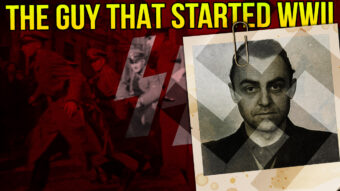
“Like the Swiss Army Knife, the popular AR-15 rifle is a perfect combination of home defense weapon and homeland defense equipment.”
Benitez’s landmark decision was but one episode in the long-running political debate over gun rights and gun control in the United States, much of which has centred on the class of firearms known as assault rifles and in particular the popular AR-15 family. To gun-control advocates, rifles like the AR-15 are deadly weapons of war unsuited to civilian use and the favoured tools of criminals and mass shooters; while to gun rights activists they are merely highly adaptable, reliable tools, no different from any other sporting firearm. But what is the truth of the matter? What is an “assault rifle”, how did it get its name, and how does this class of firearm differ from all others. The answer may surprise you.
What we now call assault rifles can trace their origins back to the Second World War. While that conflict is remembered for introducing advanced technologies like radar, jet aircraft, and nuclear weapons, the average infantryman went into WWII armed essentially the same weapon his parents had used in the last war: a bolt-action, manually-repeating rifle firing a full-power cartridge. The only major exception was the United States, which in 1936 became the first nation to issue a semi-automatic rifle – the M1 Garand – as its standard infantry weapon. But while such weapons were well-suited to shooting across no-man’s-land during the Great War or the South African Veldt during the Boer War, in the increasingly urban, close-quarters combat troops increasingly found themselves engaged in, bolt-action rifles quickly became something of a liability. Not only were they slow and awkward to operate – severely limiting the volume of fire that could be laid down – but the full-power cartridges they fired, great for precision shots over long distances, were grossly overpowered, with Army reports indicating that few combat engagements occurred at ranges over 300 metres. Such cartridges also made fully-automatic weapons all but uncontrollable when fired from the shoulder.
Thankfully, most armies had another class of weapon at their arsenal: the submachine gun. Developed at the end of the Great War for raiding and clearing trenches, submachine guns fired lower-recoil pistol-calibre ammunition and could deliver a murderous volume of fire at close quarters, making them ideal for urban combat. This advantage was exploited to great effect by the Soviet Red Army, who equipped entire infantry companies with PPsH-41 and 43 submachine guns for house-to-house fighting in cities like Stalingrad. But submachine guns were not a perfect solution, being inaccurate at ranges beyond a few dozen metres. Both the Soviets and the Germans quickly realized that this new kind of combat required a new kind of weapon, one which combined the volume of fire and full-auto controllability of a submachine gun with the accuracy of a rifle – at least over moderate ranges.
Interestingly, both nations approached the same problem from opposite ends. Unlike most armies, the tactical structure of the German Wehrmacht was organized not around the rifleman, but rather the machine gun squad, with rifle-carrying infantry playing a supporting role. This is a major reason army planners chose to retain the Great War-era Mauser 1898-pattern bolt-action rifle rather than adopt a more modern semi-automatic infantry weapon. But while this arrangement worked well during the Blitzkrieg campaigns of 1939, 1940, and 1941, it proved less effective in 1943 as the Wehrmacht found itself in full-on retreat following the disaster at Stalingrad. Though the German MG 34 and MG 42 machine guns could lay down an impressive volume of fire, they required extensive setup before they could be brought to bear – something that was difficult to do while retreating. German industry thus set about designing a more compact, man-portable machine gun that could be more easily used on the retreat.
Fortuitously, the basic elements for such a weapon were already in development. In 1938, the Polte Ammunition Works in Magdeburg designed a new kind of ammunition, designated the 7.92x33mm Kurz or “short.” This was essentially a cut-down version of the standard full-power 7.92x 57mm Mauser cartridge used in German bolt-action rifles and machine guns, with a shorter case and lighter bullet. This provided a balance between recoil and accuracy, allowing an infantryman to lay down controllable automatic fire from the shoulder while still being able to accurately hit targets out to 300 metres. In 1940 the German government issued contracts to firms Haenel and Walther to produce prototypes of a rifle to fire the new Kurz cartridge, to be designated the Maschinenkarabiner or “Machine Carbine” 42. Both companies produced similar weapons, which looked unlike anything that had come before. Both were gas-operated, built of lightweight and inexpensive welded steel stampings, and featured an inline shoulder stock, low-slung barrel to reduce muzzle climb, and a long, curved 30-round detachable box magazine. Both companies’ prototypes were extensively tested at the Kummersdorf proving grounds in December 1940, and the results were…less than impressive, with the weapons suffering a large number of jams, burst barrels and other failures. Undaunted, Walther and Haenel continued to refine their designs, and in April 1942 the Haenel weapon was judged reliable enough for combat trials, first seeing service on the Eastern Front, south of Leningrad.
The reaction of the first troops to use the new weapon was overwhelmingly positive, and they requested that more MKb 42s be sent to the front immediately. Unfortunately, the entire program suddenly fell victim to that greatest of enemies to the German war effort: Adolf Hitler, who ordered all new rifle development programs suspended. The reason for this decision is hotly debated among historians, with some arguing that Hitler, having been a soldier in the Great War himself, was suspicious of new technology and believed that the standard KAR98K bolt-action rifle was perfectly adequate for the German infantryman’s needs. Others, however, claim that his decision was a far more pragmatic one. German forces had lost vast quantities of rifles and other weapons during the retreat from Stalingrad, greatly straining the capacity of German industry to replace them. Introducing a new pattern of rifle, which required brand-new tooling and manufacturing facilities, would only make the situation worse and result in too few new rifles being produced to have any significant impact on the war effort. Hitler thus limited research and development efforts to upgraded models of submachine guns.
Believing they had a winning weapon on their hands, Haenel made the bold decision to go behind the Führer’s back and continue development of the Mkb 42 under the designation Maschinenpistole or “Machine Pistol” 43. In order to address the issue of manufacturing capacity, Haenel attempted to develop the MP 43 into a complete replacement for the KAR98K, fitting it with a grenade launching attachment, mounts for telescopic sights, and a bayonet lug. Unfortunately, the rifle proved fundamentally unsuited to sniping, bayonet fighting, or grenade launching, and it was reluctantly decided that the MP43 could only ever supplement the KAR98K, not replace it. In March 1943, Hitler discovered Haenel’s deception and ordered the project shut down once again. However, he was eventually persuaded to allow development to continue on an evaluation basis only. But the results of early trials proved so promising that Hitler approved the weapon for mass-production, the first examples entering combat in October 1943. Once again the reaction from front-line soldiers was overwhelmingly positive- so much so that when Hitler asked his Eastern Front generals in July 1944 what they most needed, one general immediately exclaimed “more of those new rifles!” Hitler soon warmed to the MP 43 concept, and recognizing the propaganda value of this new weapon, requested that it be given a new name: Sturmgewehr, or “Assault Rifle.” Nearly 426,000 StG 44 rifles were produced by the end of the war, and while they proved extremely effective in combat, by the time they entered service the war for Germany was already lost, and the new weapon had little to no impact on the final outcome of the conflict. However, the basic concept of a select-fire rifle firing an intermediate cartridge – as well as the name “assault rifle” – was to have major impact on the future of firearms design.
Meanwhile, a similar development was taking place in the Soviet Union. Recognizing, as the Germans had, the need for a cartridge halfway between a pistol and rifle in power, in 1943 the Soviet OKB-44 design bureau developed the intermediate 7.62x39mm cartridge for use in a planned family of new infantry weapons, including a semi-automatic rifle, an automatic rifle, and a light machine gun. The cartridge, along with the semi-automatic SKS rifle designed by Sergei Simonov, first entered combat in limited numbers in 1945 during the final battles against Nazi Germany. The round performed well, and in 1949 the SKS was officially adopted as the Red Army’s standard rifle, alongside the RPD light machine gun firing the same round. However, the SKS would prove extremely short-lived in front-line service, thanks to the development of a weapon that would go on to become legendary.
In October 1941, tank commander Mikhail Kalashnikov was recovering in hospital from shoulder wounds received during the Battle of Bryansk. With plenty of time on his hands, Kalashnikov decided to solve what he saw as a major deficiency in Soviet armaments and designed a new type of submachine gun for the Red Army:
“I was in the hospital, and a soldier in the bed beside me asked: ‘Why do our soldiers have only one rifle for two or three of our men, when the Germans have automatics?’ So I designed one. I was a soldier, and I created a machine gun for a soldier.”
While Kalashnikov’s submachine gun was not accepted into service, his talent as a designer was recognized and he was reassigned to the Red Army’s Central Scientific Development Firing Range for Rifle Firearms of the Chief Artillery Directorate. In 1944 Kalashnikov became aware of the 7.62x39mm intermediate cartridge and redesigned his submachine gun to accommodate it. The resulting weapon looked very similar to the German StG 44, with an inline stock, low-slung barrel, and curved 30-round magazine. Whether Kalashnikov was directly influenced by the German weapon is debatable, with most historians attributing the similarities to a case of convergent design – that is, of two designers coming up with similar solutions to the same problem. Indeed, the operating mechanism of the two rifles is quite different, the StG 44 using a tipping bolt and the Kalashnikov a rotating bolt. However, it is worth noting while the Germans were trying to create a machine gun that could be used at shorter ranges, Kalashnikov was trying to create a submachine gun that could be used at longer ranges.
In 1946 Kalashnikov entered his design into a competition for a new infantry automatic rifle, which it eventually won. In 1947, the weapon was approved for service under the designation Avtomat Kalashnikova – or “Kalashnikov’s Automatic Rifle” – 1947, better known as the AK-47. Trials of the new rifle began in 1948, and in 1949 the AK-47 was adopted as the Red Army’s standard rifle, replacing the SKS after barely a year in service. The AK family of rifles would go on to become the most successful and widely-produced firearms in history, renowned for their ruggedness, reliability, and ease of use. Millions were exported around the world by the Soviet Union, China, and other communist states, and can be found in war zones worldwide to this day. It is important to note here that while the weapon is popularly referred to as the “AK-47,” this designation technically applies to the first three patterns of the rifle. While the first AK-47 featured stamped steel construction like the StG 44, this proved unreliable and was quickly replaced by machined steel construction for the Type 2 in 1951 and Type 3 in 1954. Then, in 1959, Soviet manufacturers finally perfected the stamped-steel technology and introduced the Modernized AK or AKM. This is the AK most commonly encountered around the world, the original “AK-47” patterns being extremely rare.
Yet despite the success of the StG 44 and the AK, it took several decades for the assault rifle concept to catch on in the West. American infantry doctrine had long emphasized individual marksmanship and firing accurate aimed shots over long distances over suppressing fire, and despite the lessons of urban close-combat combat during WWII, the United States was reluctant to adopt an intermediate cartridge. In 1954 the U.S. pressured the newly-formed North Atlantic Treaty Organization or NATO into adopting the full-power 7.62×51 or .308 calibre cartridge as its infantry standard. This decision forced many NATO countries to abandon advanced assault rifle projects and adopt so-called “battle rifles” firing full-power cartridges, such as the Belgian FN-FAL, German G3, and American M14, which was essentially an M1 Garand with a detachable box magazine and select-fire capability. Unfortunately, these rifles proved less than ideal, the full-power .308 cartridge making them nigh-uncontrollable in full-automatic fire. This led many countries like the UK to delete the full-automatic capability from their battle rifles altogether.
The deficiencies of the battle rifle concept became glaringly obvious as the United States entered the Vietnam War, where the bulky, wood-stocked M14 proved prone to snagging in heavy brush and warping in the tropical humidity. By contrast, the Chinese-supplied SKSs and AKs used by the Viet Cong and North Vietnamese Army proved ideally suited to jungle warfare, being light, compact, reliable, and capable of controlled automatic fire. It quickly became clear to U.S. Commanders that an American answer to the AK was desperately needed. Thankfully, just such a weapon was already in development.
In 1954, Richard Boutelle, president of the Fairchild Engine and Airplane Corporation, created the ArmaLite division to explore the use of aluminium and other aerospace materials in firearms design. The division’s first success came that same year when it designed the lightweight folding AR-5 and AR-7 survival rifles for use by U.S. aircrew shot down behind enemy lines. In 1957, ArmaLite was invited to enter the competition for a new U.S. Forces rifle to replace the WWII-era M1 Garand, and to this end designer Eugene Stoner produced the AR-10, a lightweight aluminium-bodied rifle firing the 7.62x51mm NATO round. While the AR-10 would ultimately lose out to the M14, that same year General Willard G. Wyman, commander of the U.S. Army Continental Command, put out a request for a lightweight automatic rifle to fire the newly-developed 5.56x45mm or .223 calibre intermediate cartridge. Stoner scaled down the AR-10 design to create a new rifle called the AR-15, which after extensive trials and conversion to fully-automatic capability was adopted into U.S. service in 1964 as the M16. While the lightweight, space-age weapon was initially disparaged by troops as the “Mattel Rifle”, the M16 quickly proved its worth in the jungles of Vietnam, and Eugene Stoner’s AR system has formed the basis for all standard U.S. military service rifles to the present day. The rifle also set the trend for modern assault rifles, the 5.56x45mm cartridge being flatter-shooting and more lightweight than the Russian 7.62×54, the latter feature allowing an infantryman to carry more ammunition. As a result, in 1974 the Soviet Union replaced the AKM with the AK74 firing the broadly similar 5.45x39mm cartridge. And in 1980 NATO adopted 5.56x45mm as its infantry standard, replacing the full-power 7.62×51.
All this brings us back to our original question: just what is an assault rifle? According to the standard U.S. Army definition, to be classified as an assault rifle a firearm must have three basic characteristics embodied in the original StG 44 and AK-47: 1) it must fire an intermediate cartridge with an effective range of at least 300 metres; 2) it must have select-fire capability – that is, the ability to fire in fully-automatic mode; and 3) it must have a high-capacity detachable box magazine. By this definition, most civilian versions of the widely demonized AR-15 are not, in fact assault rifles, for while these rifles are designed to fire an intermediate cartridge and can be fitted with large capacity magazines, the AR-15 is, by definition, a semi-automatic firearm. Furthermore, “AR” does not stand for “Assault Rifle,” as is widely believed, but rather “Armalite Rifle.” Similarly, any firearm lacking one or more of the above characteristics cannot be classified as an assault rifle. For example, the original M14 has a detachable high capacity magazine and select-fire capability, but fires a full-power rifle cartridge; while the SKS, despite firing an intermediate cartridge, has only a 10-round fixed magazine and no select-fire capability.
Nor should “Assault Rifles” be confused with “Assault Weapons,” the latter being neither a technical or military term but rather a political one. The term derives from the U.S. Violent Crime Control and Law Enforcement Act of 1994, which defined “Assault Weapons” as those which possess one or more of the following features, among others:
- A pistol grip or thumbhole stock
- A folding or telescoping stock
- A grenade or flare launcher
- A forward handgrip
- A threaded barrel
- A muzzle device such as a muzzle brake, flash hider, or suppressor
- A bayonet mount
- A barrel shroud that prevents burns to the operator
- A manufactured unloaded weight of over 50 ounces (1.41 kg) for pistols
As you may have noticed, few of these features in any way affect the actual mechanical operation or deadliness of a firearm, and instead merely serve to make it look “tactical” or “scary” compared to more traditional firearms used for hunting and other sporting purposes. Unsurprisingly, this purely cosmetic definition has lead to a variety of nonsensical contradictions in the application of gun-control laws. For example, the Ruger Mini-14, a scaled-down version of the M14 chambered for the 5.56x45mm cartridge, has rarely been targeted by assault weapons bans despite firing the same cartridge and having roughly the same capabilities as the AR-15. The only major difference between the AR-15 and the Mini-14 is that the latter is typically sold with a traditional wooden stock, making it look less intimidating.
None of this, of course, has any bearing on who should be able to own which firearms and why, and it is hardly the business of this channel to wade into the highly contentious gun control debate. But as with any fraught political topic, it is always best to approach the conversation from a position of knowledge rather than ignorance. For as a paragon of quality 1980s children’s television once said: knowing is half the battle.
If you liked this article, you might also enjoy our new popular podcast, The BrainFood Show (iTunes, Spotify, Google Play Music, Feed), as well as:
- Has Anyone Ever Fired a Gun in Space, Space Cannons, and the Guns Designed for Astronauts?
- The Story of the Iconic ‘Tommy Gun’
- From Windmills to BB Guns- The Story of Daisy
- That Time Nevada Executed a Prisoner With a Shooting Machine
- During WWII, Lyudmila Pavlichenko Sniped a Confirmed 309 Axis Soldiers, Including 36 German Snipers
Erenfeicht, Leszek, Sturmgewehr: Hitler’s Only True Wunderwaffe, Small Arms Defense Journal, September 30, 2013, http://www.sadefensejournal.com/wp/sturmgewehr-hitlers-only-true-wunderwaffe/
Williams, Anthony, Assault Rifles and Their Ammunition: History and Prospects, June 22, 2008, https://web.archive.org/web/20080714163011/http://www.quarry.nildram.co.uk:80/Assault.htm
Bocetta, Sam, The Complete History of the AR-15 Rifle, Small Wars Journal, December 7, 2017, https://ift.tt/63sQ4wK
Hogg, Ian, The Illustrated Encyclopedia of Ammunition, Chartwell Books, NJ, 1985
Violent Crime Control and Law Enforcement Act of 1994, https://www.govinfo.gov/content/pkg/BILLS-103hr3355enr/pdf/BILLS-103hr3355enr.pdf
McCollum, Ian, Kalashnikov vs Sturmgewehr, Forgotten Weapons, September 17, 2016, https://youtube.com/watch?v=sPWJOJZQCs8
The post What Actually Defines an ‘Assault Rifle’ and Who Invented Them? appeared first on Today I Found Out.
from Today I Found Out
by Gilles Messier - March 31, 2023 at 06:18PM
Article provided by the producers of one of our Favorite YouTube Channels!
-

 The line between serial killer and, say, a prolific executioner such as 17th century German executioner, Frantz Schmidt, who killed 394 people and disfigured and otherwise tortured about the same number elsewise (more on him in the
The line between serial killer and, say, a prolific executioner such as 17th century German executioner, Frantz Schmidt, who killed 394 people and disfigured and otherwise tortured about the same number elsewise (more on him in the  On the first of September, 1939, nearly 1.5 million troops, 2,750 tanks, and 2,300 aircraft of Adolf Hitler’s Third Reich stormed over the border into Poland. That same day, Britain and France, bound by treaty to defend Polish sovereignty, issued an ultimatum calling for the immediate withdrawal of German forces. The ultimatum was ignored, and on September 3 the Allied powers declared war on Germany. The Second World War in Europe had begun. While Hitler’s true goal was plain for all to see, the Führer justified the invasion as a response to growing Polish aggression, pointing to a series of attacks against German citizens both within Poland and just across the border. But while many of these attacks did indeed take place, they were carried out not by Poles but rather German agents in a carefully-coordinated false flag operation designed to give Hitler the justification he needed to launch his war of conquest. This is the shadowy story of Operation Himmler.
On the first of September, 1939, nearly 1.5 million troops, 2,750 tanks, and 2,300 aircraft of Adolf Hitler’s Third Reich stormed over the border into Poland. That same day, Britain and France, bound by treaty to defend Polish sovereignty, issued an ultimatum calling for the immediate withdrawal of German forces. The ultimatum was ignored, and on September 3 the Allied powers declared war on Germany. The Second World War in Europe had begun. While Hitler’s true goal was plain for all to see, the Führer justified the invasion as a response to growing Polish aggression, pointing to a series of attacks against German citizens both within Poland and just across the border. But while many of these attacks did indeed take place, they were carried out not by Poles but rather German agents in a carefully-coordinated false flag operation designed to give Hitler the justification he needed to launch his war of conquest. This is the shadowy story of Operation Himmler.